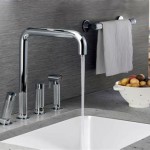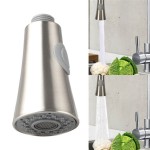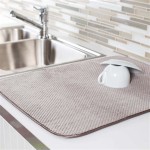Having a kitchen sink mat is a great way to keep your sink looking its best. It prevents scratches and other damage from everyday use, and it helps keep dishes and utensils from slipping and sliding around. Kitchen sink mats come in a variety of shapes, sizes, materials, and colors, so you can choose one that best fits your needs and décor. Here’s a look at the benefits of kitchen sink mats and tips for choosing the right one.
Benefits of Kitchen Sink Mats
Kitchen sink mats provide a layer of protection between your sink and the dishes and utensils you place in it. This prevents scratches and dings, which can happen if dishes and utensils are placed directly on the sink surface. They also help keep dishes and utensils from sliding around, which can be a hazard in busy kitchens. Kitchen sink mats are also easy to clean, as they can be washed in the dishwasher or with soapy water.
Another benefit of kitchen sink mats is that they help protect your sink from hot dishes. This can help to prevent heat damage to the sink surface. Kitchen sink mats also add a bit of cushioning, which can make cleaning up after cooking and other activities more comfortable. And, of course, there’s the aesthetic benefit of having a kitchen sink mat—it can add a bit of color and style to your kitchen décor.
Types of Kitchen Sink Mats
Kitchen sink mats come in a variety of shapes, sizes, materials, and colors. The most common type of kitchen sink mat is made of rubber or vinyl and is circular or rectangular in shape. These mats are usually designed to fit into the base of the sink. Other types of kitchen sink mats include those made of mesh and those with suction cups to prevent them from slipping around.
When choosing a kitchen sink mat, consider the size and shape of your sink. You’ll also want to consider the material, as some materials are more durable than others. And of course, look for a mat that is easy to clean and that fits your kitchen décor.
Tips for Using Kitchen Sink Mats
When using a kitchen sink mat, it’s important to remember to remove it before washing dishes in the sink. This will help prevent the mat from getting soaked and becoming a breeding ground for bacteria. It’s also important to clean the mat regularly to keep it free of bacteria and grime.
Finally, it’s a good idea to periodically inspect and replace your kitchen sink mat. Over time, the mat may become cracked or worn, which could lead to bacteria buildup. Replacing the mat regularly will help ensure that your kitchen sink stays clean and safe.




![Best Mat For Kitchen Sink Reviews 2022 [Buying Guide]](https://i2.wp.com/www.matforkitchenfloor.com/wp-content/uploads/2020/09/5-7-1024x1024.jpg)









Related Posts








